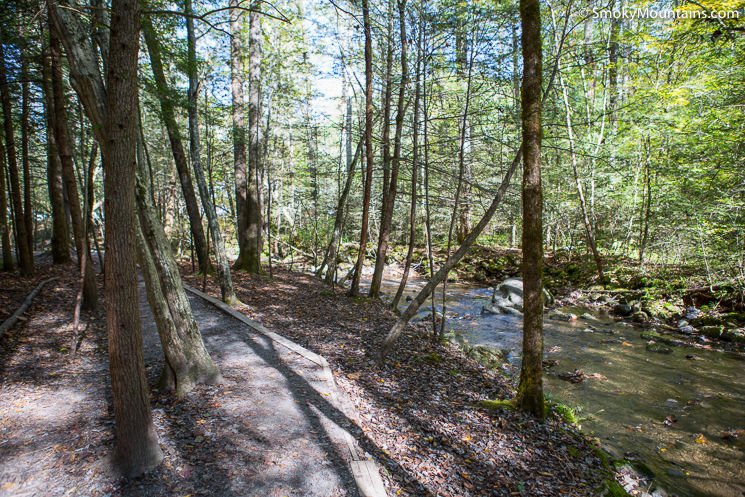Great Smoky Mountains National Park is a wonderland of water. Rushing mountain torrents and brooks, waterfall- and cascade-broken rivers, perfect for fishing. Bathed in abundant precipitation, the Smokies are defined as much by flowing water as mountain ridges and verdant forests.
Hundreds of miles of freshwater in the park support fish. These include some of the finest remaining trout streams in the eastern U.S. Lower-elevation impoundments, not least Fontana Lake, offer additional opportunities. And all of these park waters are open year-round for fishing. Great Smoky Mountains National Park, in other words, is as much a paradise for anglers as for hikers, wildflower enthusiasts, history buffs, and wildlife watchers.
In this guide, we’ll break down the basics of fishing in the park, introduce you to leading gamefish here, and point you to some worthwhile “fishing holes.”
Fish of the Great Smoky Mountains

a stream in the the smoky mountains, water rushing through the rocks
Nearly 70 species of fish are found in the Great Smoky Mountains National Park. From numerous darters to suckers, brook lampreys, and sunfish. Most are native, but there are some notable introduced species, including some of the park’s top gamefish.
The most popular Smoky Mountain fish from an angling perspective are the trout. These include the sole native species of trout, the brook trout, as well as the non-native rainbow and brown. These were released in the park during its long era of stocking, which ran from 1934 to 1974.
But a number of other gamefish are pursued here, not least the native smallmouth bass.
Fishing Regulations in Great Smoky Mountains National Park

man fishing, day time, in the mountains
To fish in the Great Smoky Mountains National Park, you need a valid fishing license from either Tennessee or North Carolina. Such a license from either state is accepted throughout the park, which, of course, straddles the boundaries of Tennessee and North Carolina. (Learn more about obtaining a Tennessee fishing license right here.)
You may only use a single hand-held rod and artificial flies or lures to fish in the park. The park prohibits bait fishing to prevent the introduction or spread of exotic aquatic organisms and to reduce hooking mortality. Speaking of it, double, treble, and gang hooks aren’t allowed in the park.
Fishing’s legal throughout the year on all park streams from a half-hour before sunrise to a half-hour after sunset.
As far as possession limits go, you’re allowed up to five brooks, rainbow, brown trout, or smallmouth bass, or any combination thereof, per day or in possession in whatever form. You may keep up to 20 rock bass on top of those possession limits. When you reach the limit, you need to stop fishing immediately.
The minimum size limit for trout (brown, rainbow, and brook), as well as smallmouth bass, is seven inches. Any fish of these species caught under that length must be returned to the water they were caught in immediately. There’s no minimum size cutoff for rock bass.
Trout Fishing in the Park

The native Southern Appalachian brook trout has lost a lot of range in Great Smoky Mountains National Park over the past century or so. Logging operations and other habitat alterations reduced its numbers, and competition with the non-native rainbow trout remains an issue. Restoration efforts are slowly allowing this wonderful native trout to reoccupy stream miles from which it had disappeared.
These days, brook trout are mainly pursued at middle and upper elevations, above 3,000 feet or so. A prime stream to target for “brookies” is the Lynn Camp Prong of the Little Pigeon River.
Opportunities to cast for rainbow and brown trout are ample below 3,000 feet. Many streams in the Great Smoky Mountains National Park harbor several thousand rainbow trout per square mile. While most rainbows are on the small side, brown trout—which switch over to preying on other fish once mature—may grow pretty hefty: sometimes past two feet long!
Smallmouth Bass Fishing in the Park

More sluggish, low-elevation rivers with plentiful woody debris and deep pools serve as high-quality habitats for smallmouth bass. Among the leading freshwater gamefish in North America, this species can be fruitfully targeted in the Great Smoky Mountains National Park at multiple locations.
These include the East Prong of Little River, Abrams Creek, the West Prong of the Little Pigeon, and several tributaries of Fontana Lake.
Fishing Tips

One of the joys of fishing in the Great Smoky Mountains National Park is the variety of angling experiences and settings. You’re spoiled with choices, from the calm coves of sprawling Fontana Lake to remote high-elevation brooks in the mountain wilds.
Bear in mind that fishing pressure is, unsurprisingly, heaviest along road corridors. Anglers with the ability and ambition to trek into the rugged backcountry are richly rewarded.
Along with the waterways mentioned already, the Oconaluftee River and Deep Creek are also top fishing destinations in the park.
The sheer beauty, biodiversity, and wildness of Great Smoky Mountains National Park ensure that, regardless of how many fish you land, an afternoon of casting here will be magical!



